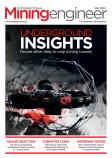Does the mining industry have the most workplace hazards? Glyn Jones explores the most common dangers – and how technology can help to mitigate them
From hazardous materials and unstable structures, to dangerous chemical gases and dust, when it comes to environmental hazards, those working in the mining sector are regularly exposed to potentially fatal dangers. Although modern safety solutions have improved safety, any misstep, equipment failure or change in atmosphere could be disastrous.
Here, we explore some of the most dangerous materials and chemicals present in hazardous operations across mining – as well as what can be done to combat these elements.
Silica dust is the first dangerous material to be discussed. The natural substance found in most rocks, sand and clay, as well as common construction materials – is the biggest risk to construction workers after asbestos. Generated through mining, processing, transportation operations and fracking, it is fine enough to get into workers’ lungs and too hard to see with normal lighting. In its crystalline form, known as respirable crystalline silica (RCS), prolonged exposure can cause lung cancer and other respiratory-related diseases.
In the USA alone, the Occupational Safety and Health Administration (OSHA) estimates that more than 2.3 million workers are potentially exposed to dust containing RCS, with a significant number of those workers employed in the mining industry.
Carbon monoxide
Referred to as ‘white damp’ or the ‘silent killer’, carbon monoxide is a colourless, tasteless gas produced by appliances where there is not sufficient air for them to work correctly, or by the combustion of coal. Carbon monoxide is present wherever fuel is burned and can be produced by home appliances, but is most prevalent in mining operations that are poorly ventilated or have confined spaces. In the UK, carbon monoxide poisoning accounts for 50 recorded deaths per year and as many as 4,000 medical visits, according to the Department of Health.
Dust is another danger. Large amounts of dust can be generated during drilling operations and explosive operations in dry conditions. Mining operations are generally a large generator of dust, due to drilling and crushing – and as a consequence, managing the volume of dust in mining operations can be difficult. Breathing in fine dust particles can lead to various health hazards. In some instances, the effects of long-term exposure to dust may not be noticeable for years or decades, but it can cause considerable damage to the body.
Asbestos – or fibrous minerals – is the commercial term for six types of naturally occurring silicate mineral fibres; and one of the most dangerous hazards miners face. Despite the inhalation of these minerals presenting significant risks, it is still one of the most common materials used in the construction trade and can be found in any industrial or residential building built or refurbished before the year 2000. According to the Health and Safety Executive, asbestos kills around 5,000 workers each year – more than the number of people killed on UK roads.
Methane, or ‘firedamp’ (a collective term given to a number of flammable gases) is produced through the extraction of fossil fuels from the earth, whether natural gas, coal or petroleum. Methane has an unpleasant ‘rotten egg’ smell - and is flammable over a range of concentrations (5.4 - 17%) in air at standard pressure. It has caused a number of disastrous mining explosions - and as it explodes, it produces deadly carbon gases, rapidly consuming oxygen in the process.
How can these problems be avoided?
With the right technology, all these risks can be mitigated and readily identified before operations begin.Dust detection and filtration technology helps protect from hazardous and fine dust emitted into the atmosphere – and ensure that permitted exposure levels (PELs) are not exceeded. Trolex provides real-time, accurate dust detection and monitoring with the AirXD, providing operators with continuous information regarding the surrounding environment and alerting them when dust exceeds PELs.
The company also offers gas detection and recovery technologies that are rapidly deployable and fully flexible. Its gas detection solutions use eModules, pre-calibrated input sensing modules designed to detect a range of toxic and combustible gases. These modules can be rapidly exchanged in real-time for instant calibration and/or maintenance.
It also provides the latest methane recovery systems, fully compliant with methane recovery regulation. These solutions are suitable for any application – and offer precise methane data recovery.
Trolex sells mine ventilation monitoring systems to protect assets, machinery and personnel, using intelligent and energy-efficient systems to track, monitor and remove hazardous particles in the operational environment. Its ventilation-on-demand (VOD) solutions use airflow sensor information to optimise the usage of ventilation fans, improving energy efficiency, airflows and overall air quality.
By using the right technologies, safety across mining operations can be considerably increased – and operators will have the tools and protection they need to conduct their activities in the most hazardous environments with confidence





















